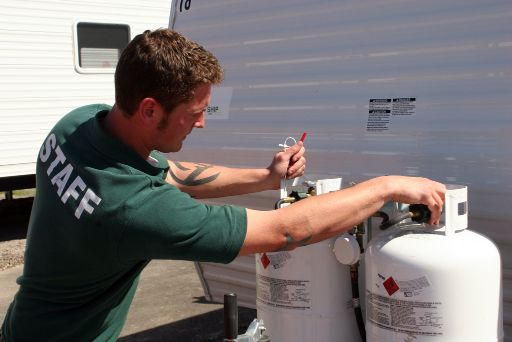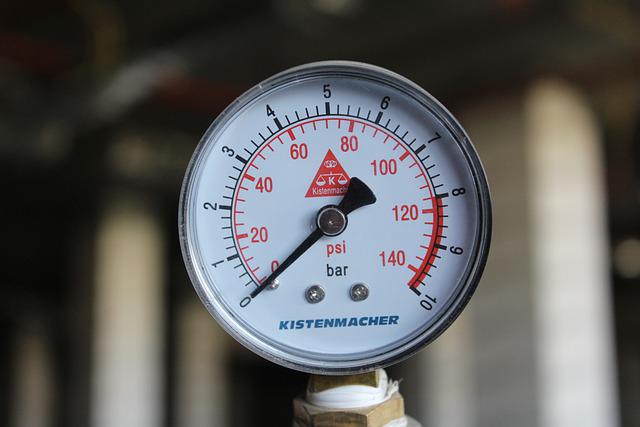
It is important to note that the actual weight of a filled 100-pound propane tank may vary slightly based on several factors, such as the tank’s construction, materials used, and even the specific propane fuel being utilized. Differences in manufacturing methods and materials can lead to variations in the weight of the tank itself, and slight differences in the composition of the propane fuel might result in minor variations in the fuel’s weight.
Additionally, propane tanks should not be filled to 100% capacity due to the need for expansion space. As propane converts from a liquid to a gas, it expands, and this expansion requires extra space within the tank to prevent excessive pressure build-up that could lead to safety hazards or even a rupture. To accommodate this expansion, propane tanks are typically filled to about 80% of their total capacity, allowing for sufficient space for the propane to expand safely.
Taking this into account, a 100-pound propane tank would actually be filled with approximately 80 pounds of propane, which translates to about 18.9 gallons (80 pounds / 4.24 pounds per gallon). When considering the weight of the tank itself, which is roughly 70 pounds, the total weight of a filled propane tank of this size would be around 150 pounds (80 pounds of propane + 70 pounds for the tank).
This estimate is based on the 80% capacity rule for filling propane tanks and accounts for the fact that the actual weight of a filled tank can vary depending on the aforementioned factors. By adhering to this rule and being mindful of the potential variations in weight, users can ensure the safe and efficient use of propane tanks for various applications.
The 80% Capacity Rule for Filling Propane Tanks
Reasons for not filling tanks to 100% capacity
Expansion of propane from liquid to gas
Propane is stored in tanks as a liquid under pressure, but it expands and converts to gas when released from the tank. Due to this expansion, it is necessary to leave room inside the tank for the propane to expand safely without causing excessive pressure. Filling the tank to 100% capacity would not allow for this necessary expansion space, potentially leading to dangerous situations.
Preventing excessive pressure build-up
As propane expands from liquid to gas, it can cause a significant increase in pressure inside the tank if there is not enough room for expansion. Excessive pressure can lead to safety hazards, such as leaks or even a rupture of the tank, which could result in serious accidents or property damage. To prevent these risks, it is crucial to leave sufficient space in the tank for the expanding propane, which is achieved by adhering to the 80% capacity rule.
How Much Does an Empty 100lb Propane Tank Weigh?
What’s Tare Weight?
Tare weight is just a fancy term for how much something weighs when it’s empty. So, for a propane tank, it’s the weight of the tank without any propane in it.
So, How Much Does It Weigh?
You might think a 100lb propane tank weighs 100 pounds, right? Well, that’s how much propane it can hold. The tank itself, when empty, usually weighs between 60 to 70 pounds. But this can vary a bit depending on the brand and design.
Tip: Always check the stamped weight on the tank itself. That’ll tell you exactly how much it weighs when it’s empty.
Remember, even without the propane, these tanks are pretty heavy! So, always handle with care.
Propane’s Weight
Weight of Propane Per Gallon:
Propane weighs about 4.23 pounds per gallon at 60°F. This weight can slightly vary based on temperature and atmospheric pressure, but 4.23 pounds is a standard average.
How Many Gallons in a 100lb Propane Tank?
To figure out how many gallons of propane a 100lb tank can hold, you simply divide the total weight of the propane by the weight of propane per gallon.
Using our average:
100 pounds ÷ 4.23 pounds/gallon = 23.64 gallons
So, a 100lb propane tank can hold just under 24 gallons of propane when filled to capacity. Remember, sometimes tanks aren’t filled to 100% to allow for propane expansion, so the actual filled volume might be slightly less in practice.
Calculating the Total Weight of a Filled 100lb Propane Tank
Adding Propane Weight to the Tare Weight:
To figure out how much a filled 100lb propane tank weighs, you start with the tank’s empty weight (tare weight). Then, you add the weight of the propane.
Here’s the Math:
1. Tare Weight (Empty Tank): Typically between 60 to 70 pounds (but always check the stamp on your tank).
2. Propane Weight: 100 pounds (because it’s a 100lb tank).
Total Weight: Tare Weight + Propane Weight
For example, if your tank’s tare weight is 65 pounds:
Total Weight = 65 pounds (tank) + 100 pounds (propane) = 165 pounds
So, What’s the Average Weight of a Filled 100lb Propane Tank?
On average, when filled, a 100lb propane tank will weigh between 160 to 170 pounds, depending on the exact tare weight of the tank.
Always keep in mind, a filled propane tank is quite heavy, so make sure to handle and transport it safely!
Factors that Can Influence the Total Weight
1. Possible Overfilling or Underfilling:
- Overfilling: Filling a tank beyond its recommended capacity can be dangerous. It doesn’t just add weight but can also cause pressure build-up, leading to potential leaks or even explosions.
- Underfilling: Sometimes, for safety reasons, tanks aren’t filled to their full capacity. This would obviously reduce the total weight compared to a fully filled tank.
2. Tank Material Variations:
- Different manufacturers might use different materials or thicknesses for their tanks, leading to variations in the tare weight. For instance, steel tanks might differ in weight compared to aluminum ones.
3. Age and Condition of the Tank:
- Over time, tanks can accumulate rust, sediment, or other impurities that might alter their weight.
Tanks that have undergone multiple refills or have been poorly maintained might experience wear and tear, which can also influence their weight.
4. Environmental Factors:
- Temperature Effects: Propane’s density changes with temperature. In colder environments, propane becomes denser, which can cause a filled tank to weigh more. Conversely, in warmer temperatures, propane is less dense and weighs less.
- Altitude: Atmospheric pressure can influence the weight and behavior of propane. At higher altitudes, with lower atmospheric pressure, propane’s weight per gallon might vary slightly.
While the weight of a propane tank and its contents can be estimated, it’s essential to recognize that multiple factors can influence the final figure. For the most accurate measurements, always weigh the tank and consider the environmental and physical conditions it has been subjected to.
Are You Filling by Weight or Volume?
How Big is 100 lb Propane Cylinder?
This size of tank is a common size for residential and commercial use. The dimensions of a 100-pound propane cylinder can vary slightly depending on the manufacturer and specific model, but they generally fall within a certain range.
Typically, this capacity of propane cylinder has a height of around 48 inches (4 feet) and a diameter of about 14.5 inches. These dimensions include the tank’s collar and base, which are necessary for its stability and protection.
Keep in mind that the actual dimensions of tis size of propane cylinder may vary slightly based on the manufacturer and design. Always consult the specifications of the specific cylinder you are using to ensure accurate measurements and proper usage.
How Do You Know When a 100 lb Propane Tank is Full?
Knowing when a 100 lb propane tank is full is essential for safe usage. There are several methods to determine if your tank is full:
- Weigh the tank: The most accurate method is to weigh the tank. As mentioned earlier, a propane tank of this size holds about 80% of its total capacity, which translates to approximately 80 pounds of propane. Considering the empty tank weighs around 70 pounds, a filled tank should weigh about 150 pounds (80 pounds of propane + 70 pounds for the tank). Weigh the tank using a scale, and if the total weight is close to 150 pounds, your tank is full.
- Use a propane tank gauge: Some propane tanks come with a built-in gauge or have an attachment that can be connected to the tank’s valve. These gauges measure the pressure inside the tank, and the reading can give you an estimate of how much propane is left. While not as accurate as weighing the tank, a gauge can still provide a useful indication of the remaining propane.
- Liquid level indicator: Some propane tanks are equipped with a liquid level indicator, such as a float gauge, which provides a visual representation of the propane level inside the tank. When the indicator shows that the tank is filled to the 80% mark, it means that the tank is full.
- Thermal strip or temperature strip: A thermal strip can be attached to the side of the propane tank, which changes color based on the temperature. When filling the tank, spray water on the thermal strip. The propane inside the tank will be cooler than the air temperature, and as the tank fills, the strip will change color, indicating the level of propane. Stop filling when the color change reaches the 80% mark on the strip.
- Sound test: This method is less accurate but can be used as a quick check. When filling the propane tank, listen for a change in the pitch or tone of the sound coming from the tank. When the sound changes, it might indicate that the tank is nearing its capacity.
Please remember that overfilling a propane tank can be dangerous. Always adhere to the 80% capacity rule and follow proper safety precautions during the filling process. If you are unsure about the process, it is best to consult a professional or have your tank filled at a certified propane filling station.
Can You fill a 100lb Propane Tank on Its Side?
Filling a propane tank of this capacity on its side is not recommended and can be dangerous. Propane tanks should always be filled in an upright position for the following reasons:
- Safety: Filling a propane tank on its side can cause liquid propane to enter the tank’s relief valve or the filling hose, which is designed to handle propane vapor, not liquid propane. This can lead to over-pressurization and potential release of propane, posing a risk of fire or explosion.
- Accurate filling: Propane tanks are designed to be filled in an upright position to ensure that they are not overfilled. When a tank is on its side, it can be difficult to determine the proper fill level, increasing the risk of overfilling the tank beyond the recommended 80% capacity.
- Proper functioning of the tank: Propane tanks are designed to operate in an upright position, with the relief valve and other components oriented correctly. Filling a propane tank on its side can cause liquid propane to interfere with these components, potentially leading to malfunctions or safety hazards.
To fill a propane tank safely and correctly, always place it in an upright position on a stable surface, and follow proper filling procedures. If you are unsure about the process, it is best to have your tank filled by a professional at a certified propane filling station.
In Summary
In wrapping up, understanding the weight of a filled 100lb propane tank is essential for both practical and safety reasons. While the name “100lb propane tank” refers to the amount of propane it can carry, the actual weight when filled encompasses both the propane’s weight and the tank’s tare weight.
Typically, a filled 100lb propane tank will weigh between 160 to 170 pounds, but this can vary based on factors such as tank material, age, and environmental conditions. As always, when handling or transporting propane tanks, it’s crucial to be mindful of their weight and handle them with the necessary care and precaution. By being informed, you can ensure safe usage, transportation, and storage of your propane tank.

Mike is an experienced propane technician with over 15 years of professional experience in the field. He has dedicated his career to helping customers with their propane needs, from installation to maintenance and repair. Together with Jeremy, he co-founded this website to provide useful information and guidance to customers seeking reliable propane services.



